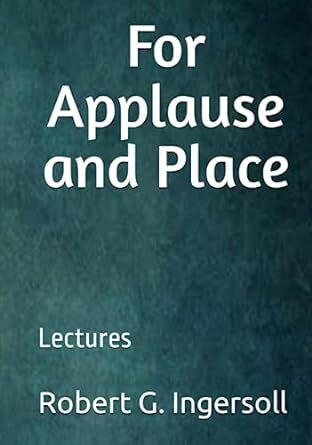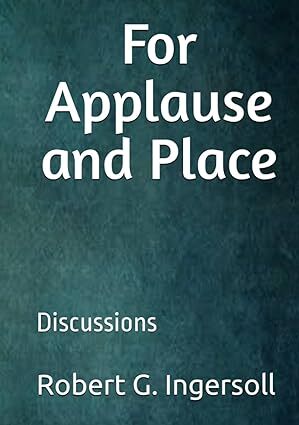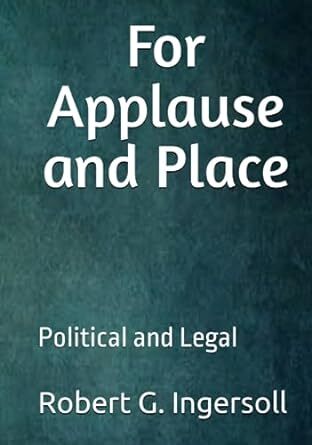All Five R. G. Ingersoll Volumes available
As we enter the year 2024, we can look back on 2023, the 190th birth year of Robert G. Ingersoll, and say that the hard cover editions upgrading the original 1900 Dresden editions of his work, are now complete and available. As America approaches another presidential election year with Christian Nationalism and facism on the table, Ingersoll’s words continue to be relevant on the dangers of such ideologies forever at this nation’s doorstep. Reading his cautions and pleas for equal rights based on reason and logic are the same today as they were over a hundred years ago. All editions available now, at Amazon.





From the FOREWORD of the Volume on LECTURES:
From the editor,
For most of my adult life, I knew nothing about Robert Green Ingersoll despite my active interest and participation in political commentary, activism and championing atheism over theism. Despite the time I spent reading, mingling with like-minded people and learning about other contributions to the subject matters, the name of Ingersoll, if it ever came up, was not imprinted on my memory. I would be confident if I said that prior to the age of forty-five years old, no one I conversed with or read ever brought him up.
It wasn’t until June 2015 that I attended the Center for Inquiry’s Reason for Change conference in Buffalo, New York, that I realized this error of history. Said conference took place between June 11-15, 2015 and described by the Center for Inquiry on their website as, “…an international conference where humanists, skeptics, and all those who value science and reason will meet to inform and inspire one another to be a positive force for change.”
And throughout the conference, numerous references could be found to Ingersoll, including a banner on the main stage and elsewhere with his face on it proclaiming, “Meet the most remarkable American most people have never heard of.”
The evening of the second day of the conference featured an Award Banquet for Susan Jacoby, author of a biography of Ingersoll entitled, The Great Agnostic: Robert Ingersoll and American Freethought (2013).
So upon closure of the conference and returning home, the first step was to seek out everything and anything Ingersoll had written only to find out his material has been largely neglected. I found twelve volumes at Gutenberg.org, an online service that publishes digital copies of books where the United States copyright has expired. And over the years, I’d pick pieces from it to digest, including diving into the man’s life itself through consumption of his biographies.
Born in Dresden, New York, August 11, 1833, Robert G. Ingersoll was raised in a religious household, his father being a traveling Christian preacher. His father’s abolitionist stance made him unpopular from time to time, causing a need for the family to uproot and find a new home. When the young Ingersoll set out to make it on his own, he tried various forms of employment in various areas of the country. He finally settled on law and settled in Peoria, Illinois in 1858. It was through his law practice, so it seems, Ingersoll fine tuned his oratory skills.
When the Civil War broke out in 1861, Ingersoll signed up with the Union and served as a colonel (a moniker for which he continued to be called) for the State of Illinois. But after being captured and spending a short stint in Confederate hands, he was returned to the State of Illinois where he continued his work in law. Then in 1867, he became the attorney general of the State. And yet despite such credentials, active participation in the Republican Party and a bid for governor (for which he lost), he never held another public office. It has been speculated, and more than likely correct, that it was Ingersoll’s distaste and active attack against religion that stopped his progress towards any other elected positions.
Despite having a minister for a father and being raised in a religious household (or, perhaps, laying the ground work and precisely because of it), Ingersoll dismissed religion, particularly that of Christianity, with the threat of eternal punishment being his most objectionable aspect. According to biographer, Orvin Larson, the most influential person in his life that swayed him into agnosticism was his wife, Eva Parker. The future Eva Ingersoll came from a family holding “unorthodox views on religion” And “Her parents were devotees of Paine and Voltaire.” Larson writes, “Had Ingersoll married a devout woman, he might not have wandered (from faith in God) again. (Larson, p. 52)
Larson notes that when Ingersoll gave up any future hopes of political office, he stopped tempering his language regarding religion and god(s), stopped giving lip service to divinity in any form in his orations. In 1869, Ingersoll gave a lecture on Friedrich Wilhelm Heinrich Alexander von Humboldt, a German naturalist, to Germans near Sulphur Springs. Within that speech, Ingersoll gave no license to any god but championed natural law. The lecture was received extremely well and launched Ingersoll on a career path of being a highly sought after orator on numerous subject matters. (Larson, p. 99-100).
After hearing Ingersoll speak on November 13, 1879, Mark Twain wrote to his wife, “…I heard four speeches which I can never forget…one by that splendid old soul Colonel Bob Ingersoll – Oh, it was just the supreme combination of English words that was ever put together since the world began. My soul, how handsome he looked as he stood on that table, in the midst of those five hundred shouting men, and poured the molten silver from his lips. Lord, what an organ is human speech when it is played by a master.” (Larson, p. 235-236) That’s quite a testament to Ingersoll’s work and a shame the best we can do is read his words in these volumes and never hear what moved Mark Twain on that night in 1879. Or on all the other occasions where Ingersoll spoke, in just about every state of the nation.
Ingersoll started his lecture circuit ten years before that moment with Twain. He gave presentations from memory on everything from religion and politics, to women’s rights and the like. According to Tom Flynn, former editor of Free Inquiry magazine and Executive Producer of The Great Agnostic documentary says, “Ingersoll composed his speeches in his head, and then retained them in memory. He always spoke without notes. His longer speeches would go three or four hours. He had a repertoire of probably forty addresses which he could deliver from memory at any time.” In the documentary, Ingersoll is described eloquently as “…the greatest orator America had ever heard. Contemporaries agreed, that his skill as a public speaker was unmatched. With dramatic flair, he combined the power of a lawyer’s closing argument and the beauty of a Shakespearean monologue.”
Susan Jacoby writes, ‘The common thread in all of Ingersoll’s thinking about social issues was secular humanism and its emphasis on the promotion of happiness in this world.” (Jacoby, p. 125) This is what set him apart from many of his contemporaries. While many of his time felt a sense of Social Darwinism, that the world had been designed, or at least established through a survival of the fittest order, Ingersoll joined with Darwin himself who felt that the higher order of human beings meant looking after all members, not leaving anyone to decks they’d been dealt with. Ingersoll championed the rights of women and African Americans to be equal to that of white men. He was in favor of immigrant’s rights, worker’s rights to an eight-hour day, public education free of religious meddling and free speech – especially that which was considered blasphemy. Jacoby writes, “What Ingersoll…understood was the indivisibility of human rights, and he understood this not in spite of but precisely because of his disbelief in a deity who had supposedly “designed” the order of nature.” (Jacoby, p. 113) Above everything else, the separation of church and state had to be implemented and humanist principles could fall in line.
Larson remarked that Ingersoll could not have excelled prior to his 1869 Humboldt lecture (found in this collection). Something was different in 1869 and later. Larson writes, “The intellectual upheaval was the outcome of many circumstances and forces: the frontier psychology that made men self-reliant and daring; the rapid advance of practical science that could make a heaven on earth; free thought from Germany that examined the origins of religion; unitarianism and transcendentalism that challenged sacerdotal authority; the Civil War that uprooted men and morals; the dawning of the Gilded Age with its worship of Mammon; and Evolution that struck directly at divine creation and the infallibility of the Bible. Traditions and patterns of conduct crumbled. As never before, people were susceptible to new ideas.” (Larson, p. 101)
However, despite Ingersoll pulling out all the stops in 1869 criticizing religion, his support of the Hayes Administration after the 1876 election gave him hope of the possibility he might yet be appointed a position within said Administration and back in political office. Hayes considered him for the Louisiana Commission but was again turned down on the grounds of his hostile attitude towards religion. William D. Porter of the law firm of Porter and Bainbridge wrote to President Hayes saying, “I believe the appointment of such a man, who disregards and scoffs at the most sacred things, would shake the confidence of all Christian men in your Administration which we now have such great hopes, and, for which we offer such fervent prayers.” Additionally, Ingersoll was considered for the German mission but again, he was turned down due to his anti-religious rhetoric. (Larson, p. 128).
And yet, despite the snub of any appointments or offices, Ingersoll continued to partake in politics, if only as a contributor of his intellect, as an influencer and advisor. In 1876, the National Liberal League was founded, an organization made up primarily of free thinkers and those tired of the old ways of doing things. The League worked its way into politics, with the goal of separating church and state of which Ingersoll became vice-president for in 1877. However, by 1880, he resigned. Ingersoll returned to the Republican Party, providing counsel and advice. During the Garfield Administration, he routinely walked from his residence (as his family moved to Washinton D.C. in 1878) to the White House to hold conversation with then President James A. Garfield.
Ingersoll managed to maintain full time employment in law, remained a political consult and highly sought after orator around the United States. He passed away July 21, 1899, just shy of the turn of the century. His work was published during his lifetime and distributed east to readers in Europe and as far west as Japan with Japanese translations. But it was not until 1900 that his brother-in-law, C.P. Farrell, started his own publishing company for the purpose of preserving Ingersoll’s work in what became twelve volumes.
Ingersoll’s Lectures, as reproduced in this one volume edition, come from the first four volumes of the Dresden Publication Company edition, that went through printings from 1900 to the last in 1929. It is currently out of print. As I found myself more and more enamored by Ingersoll’s work since being introduced to it in 2015, I set out to find a handsome printed edition for my personal library only to find no such thing existed. And to me, a bibliophile, that would not do.
It’s precisely because of that, I took on the task of reproducing those first four Dresden editions into this one volume edition that can now sit along side other collected works of great influences from the ages: From Plato to Aristotle, to Homer to the Bible, to Shakespeare and Hume, to Voltaire to Hitchens. Wearing the editor’s hat, I took the liberty of slightly changing the formatting from the original Dresden Editions, but keeping most of the archaic word choices to preserve the language.
Among that list of great influential works noted above, no other book took up so much of Ingersoll’s time as the Bible and the Judea-Christian god. No other written work has been so widely disseminated, so widely missionized and used to conquer and form a body of politics. Were Ingersoll alive this moment in time, it would still be taking up his time and he’d be making the same arguments he did in the 19th Century, only with better scholarship to assist his assault on superstition. (As an example, in the essay, Myth and Miracle, Ingersoll attributes the sacred text of the Popol Vuh to the Aztec. However, this is a Mayan text).
But the more important reason for resurrecting the Colonel’s work and presenting it in this fine edition is to keep it in circulation, to keep it relevant. Although some of the lectures in this volume are not related to religion, Ingersoll’s reputation that cost him political positions and eventually found him buried in history was his views on religion. The ever combative Ingersoll on the subject had probably seen a day when such focus would no longer be necessary. Just as no one debates the shape of the earth (no one of influence) or germ theory and such, Ingersoll saw a day when religion and superstition would pass (as demonstrated in the final paragraph of his essay, Which Way?).
Ingersoll noted how many religions and gods were already gone that it was just a matter of time before the Judea-Christian and Islamic faiths would perish as well. And yet, today, the rise of Christian Nationalism in the United States demonstrates otherwise. Ingersoll would surely be just as active today as he was during the Gilded Age.
Reviewing his lectures, criticism could be (and was during his time) lodged at Ingersoll for taking the Bible literally and basing his attack on such an interpretation. His lecture Some Mistakes of Moses and analysis of the four Gospels in What Must We Do to Be Saved are examples. Throughout his career as lecturer and champion of human rights and downgrading religious influence, Ingersoll came into dispute with numerous religious men who made literal interpretation claims as fact. His most famous dispute with the Reverend DeWitt Talmage centered around the Reverend’s insistence on the reality of Christ’s bodily resurrection and other claims of Biblical historical accuracy. Additionally, the literal interpretation of the Bible was common during his time. It was only later, as scientific findings and higher criticisms of the Bible gnawed away at taking the Bible as history did the religious find a need to stay relevant by turning to more obscure interpretations such as claims of symbolism, allegory and anagogical. Today, creationists generally don’t argue in favor of the God of the Bible but draft essays and lectures on “Intelligent Design”, as if to claim such a thing is still probable.
Susan Jacoby writes that during the composition of her book, The Great Agnostic, she paid “scant attention to the philosophical debates between Ingersoll and contemporary theologians” because audiences of such debates usually showed up already convinced their side was correct and nothing said at the debate would change their mind. However, Jacoby notes that, “Ingersoll’s genius as an advocate for freethought lay not in his ability to best clerical antagonists in arguments about the logical impossibility of the Holy Trinity…but in his impassioned portrayal of decent behavior, of goodness, as an obligation of human beings toward one another simply by virtue of their common humanity.” (Jacoby, p. 159).
Anyone who’s ever attempted to sway an opinion with facts and data is already aware that that alone is rarely a selling point. But what is generally a glue that can bind facts and data to an audience is when the presenter carries him or herself respecting those who’s opinions they’re trying to change. As they say, honey catches more flies. Ingersoll would be a welcome voice in the continuing challenge that religious influence presents today.
And yet, somewhere along the way, America (and the world at large) forgot. Just as Thomas Paine was set aside and ignored after publication of The Age of Reason, so too eventually was Robert G. Ingersoll. But whereas Paine suffered a loss of friends and reputation during his lifetime, spending his last days a pariah and a death with barely acknowledgment, Ingersoll was honored in his day. Even after his death, he was at least respected by his opponents for years to come.
At least thirty years after Ingersoll’s death, he was still showing his influence with his family and friends establishing a memorial called the Ingersoll League. People from all over the United States wrote to the League of praises for his legacy. (Larson, p. 281).
So from whence did we forget?
It appears for the same reason suffered by Thomas Paine decades before. If it weren’t for Ingersoll, America may have also forgotten Thomas Paine. America certainly tried after The Age of Reason. It wasn’t until Ingersoll championed Paine in his lecture (presented in this volume) did he force the man, his ideas and challenges to religion back into American history where he belonged.
Starting in the 1930s but increasing in urgency after World War Two, there was a perceived threat in the west, particularly in America, of a “godless Communism”. In 1954, President Eisenhower signed a bill to add “under God” to the Pledge of Allegiance. In 1956, Congress approved the use of In God We Trust as the official motto. American patriotism entangled with Christian devotion as a force to repel the Soviet Union, nothing else would suffice.
Dristin Kobes Du Mez writes, “In the 1950s…Americans of all sorts were investing in religion. Churches were springing up in new suburban neighbors across the country, and Sunday schools were bursting at the seams. Cold War politics also united Americans across party lines. To their delight, evangelicals found themselves securely within the political and cultural mainstream. The formation of the Religious Right was still two decades away, but the pieces were already falling into place. By the end of the decades, evangelicals had become active participants in national politics and had secured access to the highest levels of power.”
Ingersoll’s reputation as an infidel and agnostic were enough to limit his participation in politics back in his own day, let alone survive any lasting chance in Twentieth Century America. Any lasting influence would find a natural death in such an environment that by the end of the Cold War in the 1990s, Ingersoll was mostly forgotten outside freethought communities.
Ingersoll frequently included the following Happiness Creed in his speeches: “While I am opposed to all orthodox creeds, I have a creed myself; and my creed is this. Happiness is the only good. The time to be happy is now. The place to be happy is here. The way to be happy is to make others so. The creed is somewhat short, but it is long enough for this life, strong enough for this world. If there is another world, when we get there we can make another creed.” Additionally, this was recorded in 1894 by Thomas Edison and is one of seven brief speeches of Ingersoll’s voice.
In his presentation on Voltaire, Ingersoll noted, “A great man does not seek applause or place; he seeks for truth; he seeks the road to happiness, and what he ascertains he gives to others.” It is precisely why I chose to create this new volume of his work. To pass down to others so that they might not forget. Despite the humbleness of the quote above, it is my opinion Robert G. Ingersoll deserves a proper place and to continue to deserve applause for the path he paved that we continue to benefit from. So this edition of his lectures has been created, to give Ingersoll applause and a place. Even if the sound of one man clapping isn’t very loud, perhaps it’s loud enough to reach the attention of others so that Ingersoll’s name and contribution can be given it’s proper place in the history of the liberty of thought. As the very first sentence of his essay, “Thomas Paine” says, “With His Name Left Out, the History of Liberty Cannot be Written.” The same can be said about Ingersoll himself.
Eric Wojciechowski
January 25, 2023
Bibliography:
Du Mez, Dristin Kobes 2020: Jesus and John Wayne: How White Evangelicals Corrupted a Faith and Fractured a Nation. New York: Liveright Publishing Company.
Jacoby, Susan 2013: The Great Agnostic: Robert Ingersoll and American Freethought. New Haven & London: Yale University Press.
Larson, Orvin 1962: American Infidel: Robert G. Ingersoll. New York: The Citadel Press.
The Great Agnostic, Written, Produced, and Directed by Roderick Bradford. Execute Producer, Tom Flynn. Produced in association with the Council for Secular Humanism. Vimeo.com.



